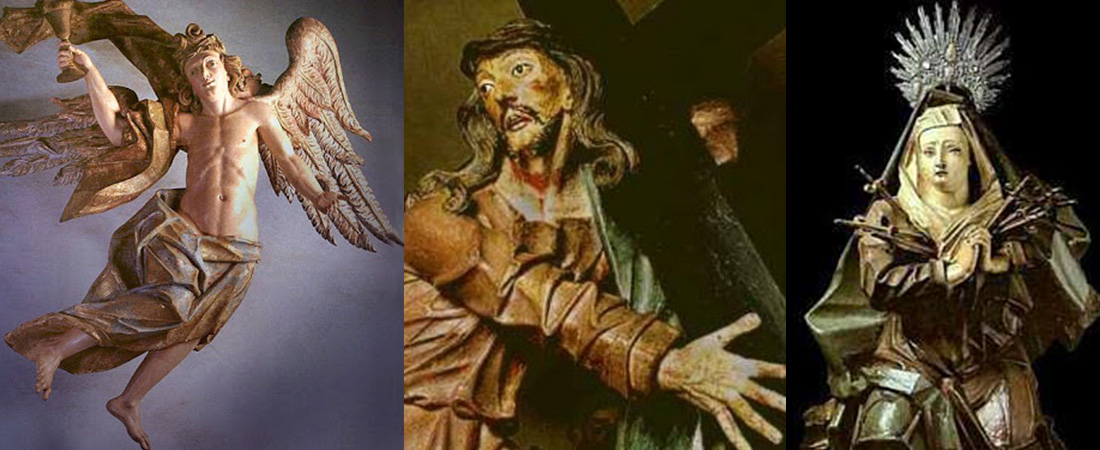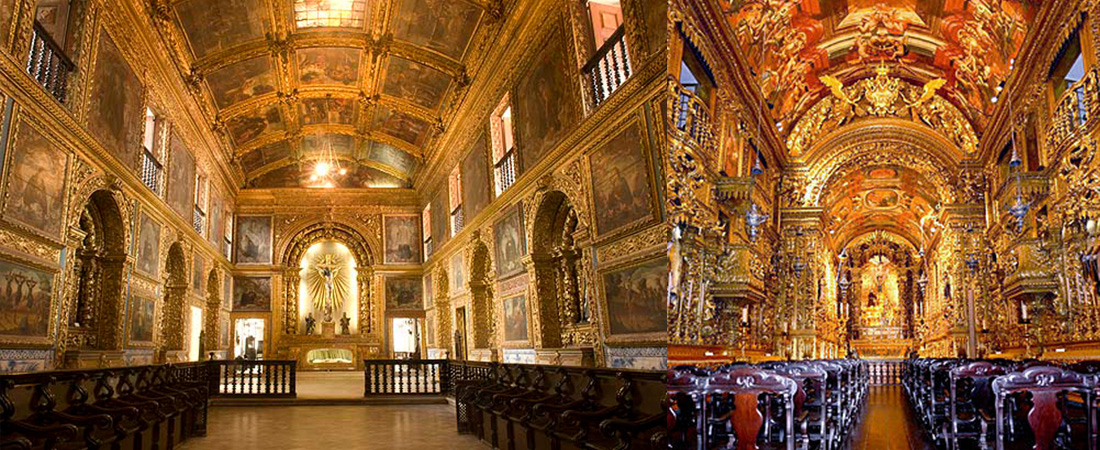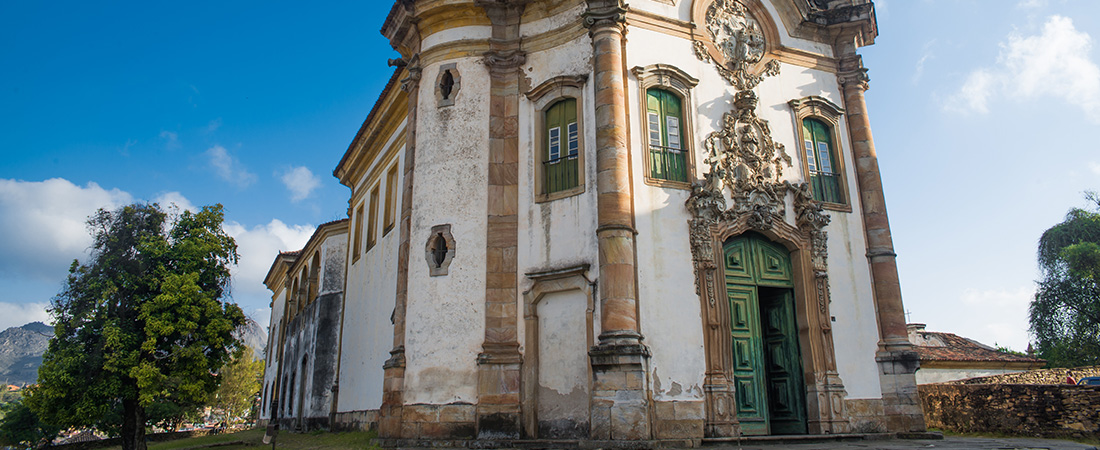Dating Problems
Bibliography science, the study of printed documents as material objects, has among its most widely researched aspects the issue of dating printed documents. Krummel, in his fundamental study concerning dating antique music publications, establishes three applications for which this item is of utter importance (1974:12-13):
- Editorial: determining the authenticity of the text
- Bibliographic: the history of the documents
- Cataloguing
In our research, one of the most problematic fields is exactly dating the publications. It is true that most of them do not pose great difficulty. Nonetheless, there are situations where we are not treading on firm ground, such as the first part of the collection Música Sacra Mineira, published by FUNARTE, with seventy-seven items (one of which is beyond the scope of our research, being a profane work). We managed to establish, through personal testimony given by Ernani Aguiar, that the period of these publications was circa the beginning of the 1980s, but we cannot establish a date for each one individually.
The greatest problem, however, resides in publications originally made in the 19th century and the beginning of the 20th century. The fact that many of them were reissued up to 70 years after the original publication creates great difficulties in dating them. Let us note that reissuing is not common in the Brazilian editorial business, but occurs mainly in the transition from the 19th to the 20th centuries, a phenomenon that resulted from the great strength of the editorial market at the time.
Let us take as examples the various publications of two works: a O Salutaris, by the engineer and composer from Paraíba, Abdon Milanez (1858-1927), of which we hold seven issues, and an Ave Maria by the composer Antônio Ferreira do Rego, of which we have five issues. The publication of both works was originally made by the company Vieira Machado & Ca. Editores.
How can we establish a chronology for these issues, different from each other in various aspects? We can observe that changes occur mainly on the cover of the publications, but the music text, in its core, is maintained intact in all issues of both works. Yet, it is in the core that few, but important non-textual changes occur, as we will see below.
Krummel points to some essential items, direct or indirect, as helpful to the effort of dating prints, of which we selected the following (Krummel, 1974: passim):
a) the plate number used for the printing – the numerical sequence of publication, usual to the publishing companies, for cataloguing purposes, allows for the so-called parachronology (Krummel, 1974:53). This item can be found either on the cover and/or the core of the publications;
b) the stated address of the publishing company – relating this address with the chronology of changes of address it is possible to come closer to a possible issue date. This item is usually found on the cover of the publications;
c) adverts of publications in periodicals of the time – as these periodicals are dated, it is possible to establish a terminus post quem – the earliest date possible – for the issue date;
d) adverts in other publications of the same company – the presence of lists of other publications by the same company is common, in the front or back cover. The changes on these lists can be used as a means to date where it occurs;
e) catalogues of publications of the company – the dates of these catalogues allow for the establishment of a terminus post quem for dating a given publication;
f) references to events or persons of a given time – dedications, changes in currency in which the publications are priced, library stamps, etc.
Other more sophisticated items can also be used, according to the author: the type of technology applied to print – typography, engraving, lithography – the paper's watermark, type of notation, copyright date, etc.
To apply Krummel's study on Brazilian printed sources we can rely on the entry “Impressão Musical no Brasil” (Musical Printing in Brazil), by Mercedes Reis Pequeno, published in the Enciclopédia de Música Brasileira (1977). In the detailed study of the researcher, who was founder and director of the Music Section of Biblioteca Nacional do Rio de Janeiro, numerous companies involved in the business of publishing music in Brazil are mentioned, from the 19th century onwards. It was a market that was constantly evolving: companies were created and extinguished, companies merged and split up, companies were inherited or bought by other companies, companies changed addresses.
In Pequeno's study, some items are of interest to us, such as:
a) the correlation between the plate number and the year of issue, a detailed item when the Bevilacqua company is concerned, with its consequences, and Arthur Napoleão, which also includes the correlation with the various addresses of the company, with its consequences.
b) correlation between different company names and periods of activity;
c) correlation between company's addresses and period of activity.
Pequeno's study unavoidably has its imprecisions, but it is useful as an important guide for the problem of dating Brazilian printed sources. The study’s lack of bibliographic references only is regrettable, as it would facilitate the work of new researches.
Casa Vieira Machado & Ca. Editores, a Rio de Janeiro company responsible for the original publication of O Salutaris and Ave Maria had the procedure, not always systematic, of placing the date of publication together with the plate number.
In the table below, we can see an outline of the correlation between plate numbers and the issue date, according to our research at National Library of Rio de Janeiro (Biblioteca Nacional do Rio de Janeiro ) and at Alberto Nepomuceno Library:
Table 1 – Correlation between plate numbers and year of publication of the company Vieira Machado
| Plate numbers | Issue year |
|---|---|
| 981 | 1901 |
| 1016 | 1902 |
| 1021 | 1902 |
| 1047 | 1902 |
| 534 | 1907? |
| 728 | 1907? |
| 840 | 1907? |
| 1083 | 1908? |
| 1233 | 1904 |
| 1237 | 1904 |
| 1307 | 1905 |
| 1423 | 1910 |
| 1428 | 1910 |
| 1486 | 1912 |
| 1498 | 1912 |
| 1543 | 1913 |
Note the inconsistency in the correlation between the plate numbers in the years 1907 and 1908. It seems like a paralel numbering. The various circumstances that cause inconsistencies of the printing companies in relation to plate numbers are exemplified in detail by Krummel (1974:53-64).
Abdon Milanez’s O Salutaris
It is possible to establish the original issue date of Milanez’s O Salutaris, as it is clearly stated in most available copies: October 1901 (10 1901). The plate number is V.M & C.981.
The apparently oldest issue we have of this work’s publication (CMSRB-122/006) shows the address of the company as Rua dos Ourives 51 (currently Rodrigo Silva, in Rio de Janeiro city center), dating it thus between 1901, the original issue date and 1908 the latest date Vieira Machado was located at that address (Pequeno, 1977:358). Some complementary items could help us pin the date with precision: the handwritten name of the owner of the issue, Adelaide Fragoso, and the cataloguing stamp of the National School of Music library. The reference to the National School of Music is not very helpful, since the school took on that name from 1937, in other words, a date much later than the period that concerns us.
Following the likely sequence of events, we found a republication of this work in the period between 1911 and 1925 (CMSRB-122/004), period in which the company was located at Rua do Ouvidor 179 (Pequeno, 1977:358), the address stated on the cover. One should note that the original issue date is not stated, but the plate number remains in the core, as is the usual practice. As complementary items we found two stamps mentioning the National School of Music, which are not very relevant for the reasons stated above, and a stamp indicating a donation by José Albuquerque Lima. A more promising item is the advert on the cover, “Músicas para Canto” (“Music for Singing”), containing a listing of other publications by the same company, with their respective prices. Establishing the composition date of one such work could help date the reissue in question, for instance.
After that we have a reissue, probably in 1925 or 1926 (CMSRB-122/026). Here, the fundamental information is Minas-born pianist Guilherme Fontainha’s (1887-1970) association with the publication (Pequeno, 1977:358). Again the original issue date is not available, but the plate number remains at the core. It is worth noting the inclusion of a phone number, North 5937. An investigation into the phone books of the early 20th century could help establish the exact period in which this firm began using this telephone number, as a further item to help establish the reissue date. Another “Music for Singing” advert is displayed on the cover, but without the prices and with few works in common. One should also note the stamp of the Sao Paulo company Casa Sotero – Campassi & Camin, located at Rua Direita 37, the address it started using from 1921 (Pequeno, 1977:360).
In a different issue dating from the same period (CMSRB-122/008), again we found the original issue date in the core. The novelty is stamp from Casa Mozart, founded in 1905 in Rio de Janeiro and active until the 1940s (Pequeno, 1977:358), as well as a new advert list on the back cover entitled “Canções Brasileiras” (“Brazilian Songs”).
The fifth issue (CMSRB-122/005) presents the republished work as being edited by E.A.M (Ernesto Augusto de Matos), pointing to Rádio Continental Ltd., retailers of radio devices and similar equipment as the holders of the copy. The period of this publication lies within 1934, the year when Ernesto Augusto de Matos took on control of the company (Pequeno, 1977:358), and 1942, as inferred by the currency used, the mil-reis, which was replaced by the cruzeiro in October of that year. The plate number was changed to E.A.-3-M, in the core, following a criterion we are still unable to determine. Further works of information: the same Casa Mozart stamp, the owner’s handwritten name, Olga Nobre, and a new list-advert entitled “Trechos Originaes Modernos / ara (sic) piano” (Original Modern Passages for the piano), including prices. One should note that the front cover is very basic, containing no illustration.
The sixth issue (CMSRB-122/014) presents a new catalogue (plate) number, E.A.M 20021, displayed both on the cover and in the core. A new piece of information is the association with the company name Irmãos Vitale Editores, founded in Sao Paulo in 1923, having been active there and in Rio de Janeiro. The price, still stated in mil-reis currency, indicates a period prior to 1942, for the above-mentioned reason. On the back cover we find a list-advert entitled “Brazilian Songs”, with new layout and new works. One should note that the majority of prices of the works corresponds to those in the earlier issue. Furthermore, the number 0019, displayed on the back cover, probably indicates the number of the particular issue in the batch. We can also find the addresses of Irmãos Vitale in Sao Paulo and in Rio de Janeiro.
The seventh and last issue available (CMSRB-122/022) has a few characteristics in common with the earlier one: the same cover illustration and the same association with Irmãos Vitale – Editores, in São Paulo and Rio de Janeiro. There are however some significant changes. The catalogue (plate) number changes again, this time to E.A.M. 21, both on the cover and in the core; the printed price is stated in cruzeiros (Cr$ 3,00), indicating a period post October 1942. The price is actually crossed out, having been increased to Cr$ 5,00, according to the stamp. The back cover displays the same list of “Brazilian Songs”, but no longer with the address of Irmão Vitale in Rio de Janeiro, though their Sao Paulo address remains. Curiously, the price of the publications announced are still in the mil-reis currency, which leads us to believe that the reissue must have occurred at the time of the currency change, in other words, possibly in 1943. The issue number of this batch is 255. Let us also note the company stamp of Casa Arthur Napoleão – Sampaio Araújo & Cia Ltda, established at Av. Rio Branco 122, in Rio de Janeiro. This company moved to that address from 1913 (Pequeno, 1977:357), a piece of information that is very helpful in dating the publication to a period post 1942, as pointed out above.
Antônio Ferreira do Rego’s Ave Maria
Moving forward with our dating efforts, we shall examine five issues of Antônio Ferreira do Rego’s Ave Maria. The low number on the plate, V.M and C. 106, sets the most likely original issue date as 1893. As a reference we can use the original issue date of Viva la Gracia, a waltz for piano composed by Chiquinha Gonzaga, published in 1894 under plate number V.M and C.194. The Fontes & Cia Novo Empório Musical company was founded in 1891, followed by Vieira Machado & Ca. Editores from 1893 (Pequeno, 1977:358). The two first issues available to us, that we consider to be the oldest, are identical as far as the artistic composition of the cover is concerned. The address stated on both issues, Rua dos Ourives, 51, shows that they were issued between 1893 and 1908, period in which the publishing company was located at that address, and operated under that name, as seen above. However, there are some small, yet important, differences. The issue we have come to consider the oldest (CMSRB-018/024) contains a plate number, displayed at the top, in the core, with the words “Officina Litho-Zincographica de Vieira Machado & C.” on the cover, which do not show in the second issue. The most important piece of information, however, is the fact that the second issue (CMSRB-018/033) contains a phone number, “Telephone–1051” on the cover, absent from the first. We can naturally suppose that in those days the presence of a phone number indicates something newer, more recent. This second issue carries also a second handwritten date, “13-4º. 1908”, which corroborates the terminus ante quem – the most recent possible date – established above for this publication. One can also note on the top left corner an illegible dedication.
The third issue (CMSRB-018/049) sets the company at Rua do Ouvidor, 179, which helps us place it between 1911 and 1925, period in which Vieira Machado was located at that address. The plate number remains in the core and one can find on the front cover a list of other works published by the company, “Music for Singing”, as mentioned above. This issue thus shares the same characteristics as the second issue of O Salutaris analyzed above.
The fourth issue (CMSRB-018/023), from a much later date, has all the same characteristics of the fifth issue of O Salutaris analyzed above: a basic cover, an association with Ernesto Augusto de Matos (Edição EAM) and Rádio Continental Ltd and the price still stated in the mil-reis currency, placing it between 1934 and 1942. Furthermore, it is worth mentioning an illegible handwritten note at the top left corner, probably the name of the owner, and a Casa Arthur Napoleão stamp.
Finally, the fifth issue (CMSRB-018/050) has all the same characteristics as the seventh issue of O Salutaris analyzed above: the same cover illustration, Edição EAM associated with Irmãos Vitale, the price already stated in cruzeiros. A new aspect, however, is the information printed on page 2, “Approved by the D.I.P 2 / EM / 1264”. This piece of data is decisive in establishing an approximate date, since the acronym D.I.P refers to the Departamento de Imprensa e Propaganda (Press and Propaganda Department) created by president Getúlio Vargas in 1939 and abolished in 1945. Adding to that the price stated in cruzeiros, one can date the publication as having occurred between 1942 and 1945.
Conclusion
Cataloguing print sources demands their issue dates are established. This item often poses a problem, owing to the fact that many publishing companies that were active in the late 19th and early 20th centuries did not record this precious information in a straightforward manner. Krummel and Pequeno’s studies are immensely helpful in the efforts of dating printed sources, giving us resources for that purpose. This research is still ongoing and the date presented herein are not conclusive. Our objective here was simply to use the seven issues of Abdon Milanez’s O Salutaris and the five issues of Antônio Ferreira do Rego’s Ave Maria as a means of dating them, whilst stressing the information contained in those issues – many still not investigated – which may lead to an even more precise result.
© 2017 Carlos Alberto Figueiredo | All rights reserved.


